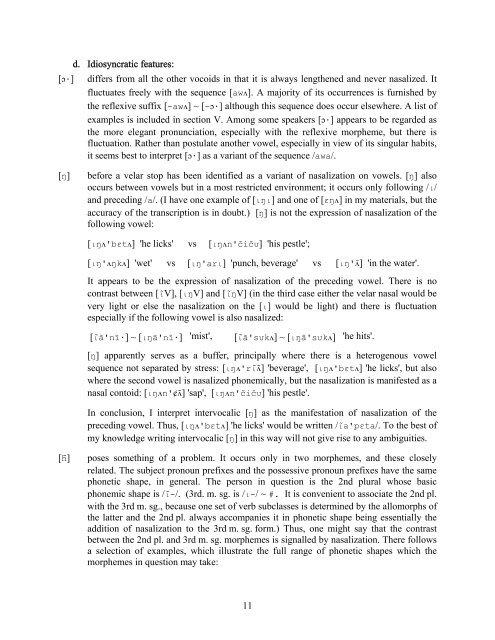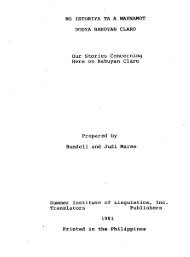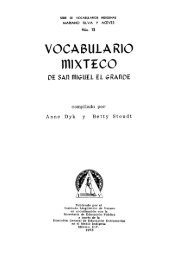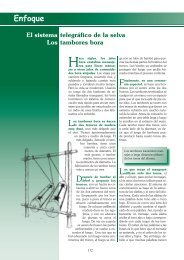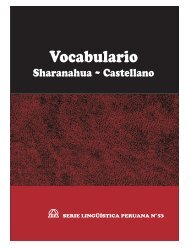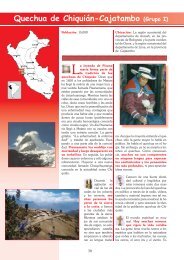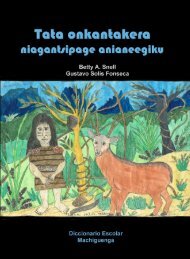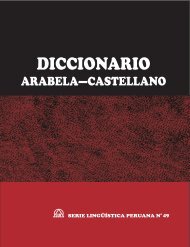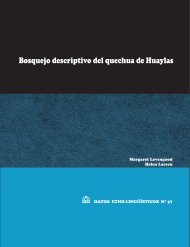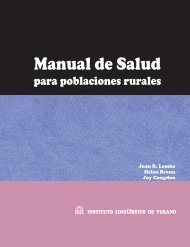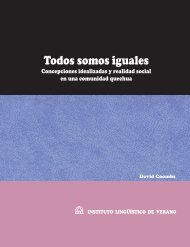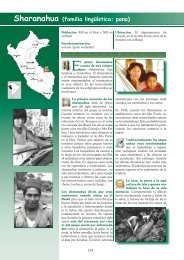A Phonemic Analysis of the Apurinã Language
A Phonemic Analysis of the Apurinã Language
A Phonemic Analysis of the Apurinã Language
Create successful ePaper yourself
Turn your PDF publications into a flip-book with our unique Google optimized e-Paper software.
d. Idiosyncratic features:[ɔ·] differs from all <strong>the</strong> o<strong>the</strong>r vocoids in that it is always leng<strong>the</strong>ned and never nasalized. Itfluctuates freely with <strong>the</strong> sequence [awʌ]. A majority <strong>of</strong> its occurrences is furnished by<strong>the</strong> reflexive suffix [-awʌ] ~ [-ɔ·] although this sequence does occur elsewhere. A list <strong>of</strong>examples is included in section V. Among some speakers [ɔ·] appears to be regarded as<strong>the</strong> more elegant pronunciation, especially with <strong>the</strong> reflexive morpheme, but <strong>the</strong>re isfluctuation. Ra<strong>the</strong>r than postulate ano<strong>the</strong>r vowel, especially in view <strong>of</strong> its singular habits,it seems best to interpret [ɔ·] as a variant <strong>of</strong> <strong>the</strong> sequence /awa/.[ŋ]before a velar stop has been identified as a variant <strong>of</strong> nasalization on vowels. [ŋ] alsooccurs between vowels but in a most restricted environment; it occurs only following /ι/and preceding /a/. (I have one example <strong>of</strong> [ιŋι] and one <strong>of</strong> [εŋʌ] in my materials, but <strong>the</strong>accuracy <strong>of</strong> <strong>the</strong> transcription is in doubt.) [ŋ] is not <strong>the</strong> expression <strong>of</strong> nasalization <strong>of</strong> <strong>the</strong>following vowel:[ιŋʌ'bεtʌ] 'he licks' vs [ιŋʌn'čičυ] 'his pestle';[ιŋ'ʌŋkʌ] 'wet' vs [ιŋ'arι] 'punch, beverage' vs [ιŋ'ʌ̃] 'in <strong>the</strong> water'.It appears to be <strong>the</strong> expression <strong>of</strong> nasalization <strong>of</strong> <strong>the</strong> preceding vowel. There is nocontrast between [ιṼ], [ιŋV] and [ι̃ŋV] (in <strong>the</strong> third case ei<strong>the</strong>r <strong>the</strong> velar nasal would bevery light or else <strong>the</strong> nasalization on <strong>the</strong> [ι] would be light) and <strong>the</strong>re is fluctuationespecially if <strong>the</strong> following vowel is also nasalized:[ι̃ã'nĩ·] ~ [ιŋã'nĩ·] 'mist',[ι̃ã'sυkʌ] ~ [ιŋã'sυkʌ] 'he hits'.[ŋ] apparently serves as a buffer, principally where <strong>the</strong>re is a heterogenous vowelsequence not separated by stress: [ιŋʌ'rι̃ʌ̃] 'beverage', [ιŋʌ'bεtʌ] 'he licks', but alsowhere <strong>the</strong> second vowel is nasalized phonemically, but <strong>the</strong> nasalization is manifested as anasal contoid: [ιŋʌn'ȼʌ̃] 'sap', [ιŋʌn'čičυ] 'his pestle'.In conclusion, I interpret intervocalic [ŋ] as <strong>the</strong> manifestation <strong>of</strong> nasalization <strong>of</strong> <strong>the</strong>preceding vowel. Thus, [ιŋʌ'bεtʌ] 'he licks' would be written /ιã'pεta/. To <strong>the</strong> best <strong>of</strong>my knowledge writing intervocalic [ŋ] in this way will not give rise to any ambiguities.[h̃]poses something <strong>of</strong> a problem. It occurs only in two morphemes, and <strong>the</strong>se closelyrelated. The subject pronoun prefixes and <strong>the</strong> possessive pronoun prefixes have <strong>the</strong> samephonetic shape, in general. The person in question is <strong>the</strong> 2nd plural whose basicphonemic shape is /ι̃-/. (3rd. m. sg. is /ι-/ ~ #. It is convenient to associate <strong>the</strong> 2nd pl.with <strong>the</strong> 3rd m. sg., because one set <strong>of</strong> verb subclasses is determined by <strong>the</strong> allomorphs <strong>of</strong><strong>the</strong> latter and <strong>the</strong> 2nd pl. always accompanies it in phonetic shape being essentially <strong>the</strong>addition <strong>of</strong> nasalization to <strong>the</strong> 3rd m. sg. form.) Thus, one might say that <strong>the</strong> contrastbetween <strong>the</strong> 2nd pl. and 3rd m. sg. morphemes is signalled by nasalization. There followsa selection <strong>of</strong> examples, which illustrate <strong>the</strong> full range <strong>of</strong> phonetic shapes which <strong>the</strong>morphemes in question may take:11


